|
Bach Flower Remedies:
Form & Function
by Julian Barnard
A Call for the Renewal
of
Flower Essence Therapy
by
Richard Katz
|
|
Julian Barnard's book,
Bach Flower Remedies: Form & Function, is a substantive and original
contribution to flower essence literature, based upon genuine research
and observation. It springs from a deep well of personal experience,
the fruit of the author's life work as a practitioner, teacher, writer,
and preparer of the flower remedies of Dr. Bach. In truth, the book
represents two men's life work, a kind of musical counterpoint in which
Barnard weaves his own observations artfully with Dr. Bach's words
and deeds.
|
Barnard's book can be read on many levels: as a further
biography of Dr. Edward Bach, a preparation manual for the sun and boiling
methods, a comparison of homeopathy and flower essences, a field guide to
the Bach remedy plants, a study of the soul "gestures" of the plants
in relation to their essence qualities, or a treatise on a system of flower
essence therapy based on three groups of essences. As a whole, Form & Function
is a call for the renewal of flower essence therapy based on its founding
spiritual principles.
If the remedies really work — and I, like many
others, have experienced them working — there is real meaning in
the way that a plant grows. The idea which instructs form cannot be based
upon chance. There is, as Bach would say, a Grand Design behind the physical
world of living beings. A grand design and a grand designer. This book
is an attempt to represent aspects of that design at work."
— Julian Barnard, from the Author's Preface
The Evolutionary Development of Dr. Bach's Work
When we examine Dr. Bach's life we immediately encounter
a problem. There is only one brief and somewhat sentimental biography, written
by his assistant, Nora Weeks. Furthermore, Weeks reveals that Bach burned
his research papers in a great bonfire during the last year of his life.
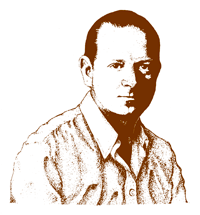
Dr. Edward Bach
Julian Barnard is a true scholar of Dr. Bach's life, perhaps
more than anyone else alive today. He is the editor of
Collected Works,
the first complete collection of Dr. Bach's published writings, and the author
of
Patterns of Life Force, a review of Bach's life published
in 1988. In
Form & Function, Barnard does not so much present
us with new facts about Bach's life as put what is known into context.

Julian Barnard
"Looking at the development of Bach's
ideas, from medical school, through the years of hospital work and on to
his later research, one thing is clear. He traveled a road of increasing sensitivity: from surgery
through bacteriology, to homeopathy and flower remedies...to assert the primacy
of spirit over matter. For him the pathway was to lead to just this place,
where the medicine of materialism was abandoned in favor of the plant-healers
from nature. Yet both are given up in favour of the word, the logos of the
Spirit."
— Julian Barnard, from Chapter 1, "Growing Sensitivity"
Barnard avoids the simple conclusion that Bach's discoveries
were an instant psychic revelation, as if they emerged from the womb of creative
ideas full-grown. Through his extensive study of Bach's writings, Barnard
shows us a truer picture of the ever-changing, evolving nature of Bach's
discoveries. For example, the first "flower remedies" of Impatiens,
Clematis, and Mimulus in 1928 and 1929 were actually homeopathic preparations,
either made from the seeds of the plant or the macerated flowers. It was
only after his development of the sun method in 1930 that we can say that
flower essence therapy was born.
|

Impatiens
|
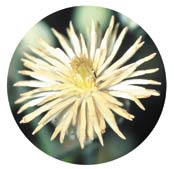
Clematis
|
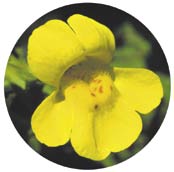
Mimulus
|
We also learn of three early flower essences that were later
discarded: Cupressus (Cypress), Cotyledon (Pennywort), and Sonchus (Sow Thistle).
Furthermore, early descriptions of some of Bach's flower essences changed
dramatically as his understanding evolved. These details do not detract from
our appreciation of Bach's work. Rather, they elevate it. We can appreciate
Dr. Bach as a genuine scientist working in the realms of subtle healing,
testing out his hypotheses, and forging ahead with new insights and discoveries.
The Sun and Boiling Preparation Methods
Why did Bach boil his last 19 remedies, rather than use
the sun method? Since there are no indications from Bach on this subject,
Barnard provides his own thoughtful hypothesis.
First of all, Barnard dismisses popular assumptions with
basic facts. It is true that there are often few sunny days in England, particularly
in the early spring. However, Bach used the boiling method in both spring
and summer of 1935. Meteorological records show, through Barnard's documentation,
that the English summer of 1935 was unusually sunny. Was not the method used
for the more robust tree essences? This is true for many, but the delicate
Star of Bethlehem was also a "boiler," while the tough Olive and
Gorse, for example, were prepared by the sun method.
|
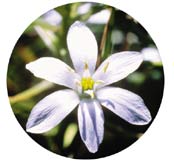
Star of Bethlehem
|
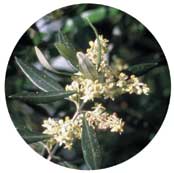
Olive
|
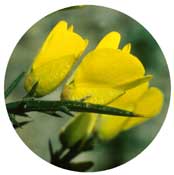
Gorse
|
|
|
|
Barnard proposes that the sun and boiling method are alchemical
polarities. The sun method incarnates fire from the sun radiating down to
the earth. By contrast, Barnard posits that the boiling method catalyzes
fire within the earth, radiating out to the cosmos. This leads to Barnard's
insight about the groupings of Bach's essences.
Three Therapeutic Groups of Bach Remedies
A central thesis in Barnard's work is that the chronological
development of Bach's essences mirrors their therapeutic use. First there
were the "Twelve Healers," considered as constitutional "type
remedies," prepared from 1928 to 1932 (with the Impatiens, Mimulus,
and Clematis re-made in 1930 using the sun method). Then there were the "Seven
Helpers," for chronic and habitual emotional conditions that can mask
the soul type, prepared in 1933 and 1934. Finally, there is the second group
of 19 remedies, all prepared from March to July of 1935 by the boiling method.
These are the remedies for emotionally reactive states resulting from trauma
and pain.
Barnard finds great value in the 12+7+19 grouping, though
he does not unquestioningly accept all of Bach's attempts at numerological
categories. For example, Barnard does not give credence to Bach's earlier
correlations (later abandoned) with the seven chakras or the 12 zodiacal
signs, or the seven categories described in subsequent writings. However,
it is evident that Bach was quite interested in the esoteric significance
of numerological patterns. This research may very well have led Bach to work
with groupings of flower remedies in patterns of 12 and 7, then a final combination
of 12 plus 7 again (19), for a total of 38 remedies.
(Editor's note: We invite case reports and commentary
from practitioners regarding Barnard's hypothesis about the three groups
of Bach essences, especially the application of the general theory to clinical
experience.)
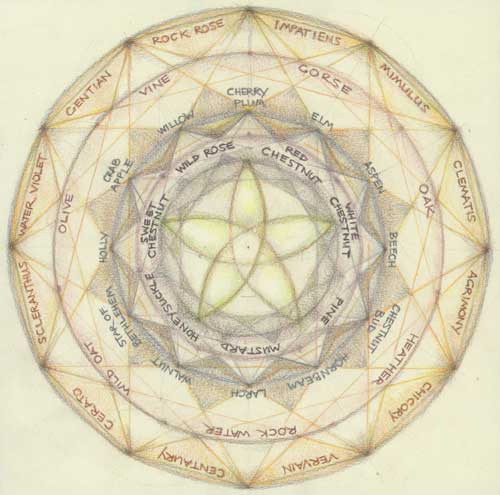
Reading the Gesture of Bach's Plant Remedies
Form & Function
is an especially significant contribution for its detailed and perceptive descriptions of the Bach flower plants. We know from Nora Weeks that Bach "spent the day examining a great variety of plants, noting where they grew, what soil they chose to grow upon, the colour, shape and number of their petals, whether they spread by tuber, root or seed..." He devoted hours studying "the habits and characteristics of each flower plant and tree." Bach urged Weeks to recognize each of the remedy plants at every stage of its growth. But Barnard admits that precisely how Bach worked with these observations" is not clear from any records he published."
In these few words, Julian Barnard has summed up the key
enigma of Dr. Bach's work, one that has challenged the research standards
for flower essence development ever since. Barnard addressed this conundrum
in 1988 when he stated in
Patterns of Life Force
(pp.
66-67):
Well, we have a choice. We may decide to leave him on
his side and say his was an insight and inspiration that is beyond us,
or we may choose to build a bridge that will take us across to a deeper
understanding of how it works and why. Those who prefer the first course
of action are left with his system of healing and can rejoice in the fruits
of this work. An explanation such as it is will be that he was an extraordinarily
sensitive man who had wandered and was led, who found through suffering
and personal affliction: a blind and painful discovery. But Bach's work,
his writings and his flower remedies invite another view, and while it
is more demanding, it is also more rewarding.
If we truly understand the importance of Bach's work, it
is not simply a "system" of 38 flower remedies. It is the possibility
that we humans can become fluent in the healing language of Nature. We are
challenged to open our eyes to the wonder of the natural world as a living
script, a soul-imbued life that can speak intimately to the human soul.
Placing Bach's Work in Historical Context
We know that Bach was familiar with the work of the Swiss
alchemist/physician Paracelsus (1493-1541) due to the brief mention he makes
of him, along with Hippocrates and Hahnemann, in the first chapter of
Heal
Thyself
(Collected Writings, p. 127)
and in addresses such as
Ye Suffer from Yourselves
(Collected
Writings
, p. 111). However, it is not accurate to say that Paracelsus "discovered" flower
essences, as claimed by some flower essence writers. Julian Barnard clearly
establishes the originality of Dr. Bach's discoveries, and its place in history
as more than a replication of prior alchemical approaches.
Nevertheless,
Form & Function
does not adequately
address the larger historical and cultural context for Bach's discoveries,
or even the precedent for Barnard's own approach to plant gesture. Bach was
a student of esoteric Masonic teachings that belong to a larger alchemical
stream in history. He also was clearly cognizant of Paracelsus, who established
the idea of the "Doctrine of Signatures." Thus it is likely that
Bach recognized correspondences of form and function between the soul gestures
of plants and human beings.
The alchemical/Rosicrucian tradition was also significantly
advanced in Europe by the German poet/scientist Johann Wolfgang von Goethe
(1749-1832), who emphasized the "gesture" of a plant as the quality
of its expression through form, color, growth, and other patterns, in contrast
to the prevailing
quantitative
and materialistic bias of the time.
The Goethean approach to nature science has developed over the last two centuries
into a diverse, worldwide school of professional scientific research and
methodology, with significant contributions to many fields of science, including
agriculture, medicinal plants, and botany.
We cannot ascertain from Bach's own writings to what extent
he worked consciously with alchemical or Goethean influences in his study
of plant gestures, nor can we gauge the precise impact of research from contemporary
colleagues such as Dr. Robert Cooper's arborivital remedies.
Nonetheless,
it is clear that Bach's healing methods and plant discoveries belong to a
larger alchemical, historical development of nature science that places value
not on physical substance alone, but also on the soul archetypes that shape
and form substance into "gesture."
The overriding goal of
Form & Function
is to
establish a wider context for Bach's healing work. Barnard argues that Bach's
work evolved through various stages of personal insight and research. Similarly,
we can also see the progressive development of Bach's research in relationship
to a larger evolutionary stream of spiritual and natural science. Establishing
such context does not minimize the individual and unique contribution of
Dr. Bach, but rather expands our understanding of its significance for our
time.
Barnard is right to give prominence to the observation of
plant qualities in
Form & Function. The concept of plant gesture
is the central thesis of Form & Function and, indeed, it is the "bridge" to
building the new plant science that Barnard first wrote about in Patterns
of Life Force.
The Healing Herbs of Edward Bach
,
first published in 1988, was Barnard's first discussion of plant gestures
in the Bach remedies, providing photographs, clear botanical information,
and some correlation of plant characteristics to essence qualities. In Form & Function,
that work has matured. Barnard weaves together detailed plant observations,
based upon Bach's scant commentary, and with his own perceptive insights.
Barnard's work is an outstanding contribution by an author who has spent
many hours in the field in devoted contemplation of Bach's plants. Consider,
for example, these excerpts from his portrait of
Water Violet:
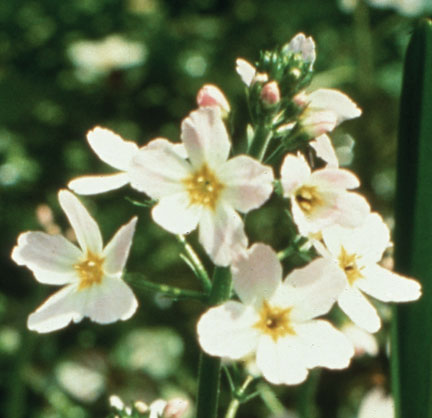
Water Violet grows, not just by the river, like Mimulus
and Impatiens, but actually submerged in water... Only in May and June
do the stems rise clear of the water, straight and elegant, as they lift
flowers into the sunlight. Bach wrote of the Water Violet soul:
These are very beautiful people in mind and often in body.
They are gentle, quiet, very refined and cultured and yet are masters of
their fate and lead their lives with a quiet determination and certainly.
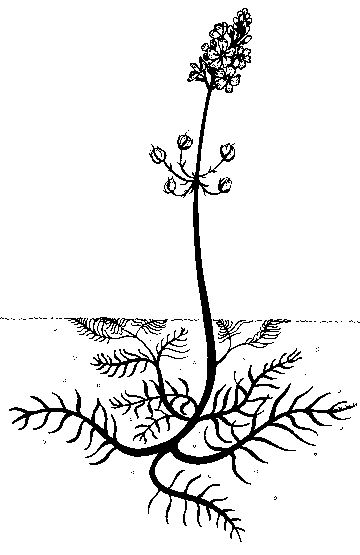 This
statement is apt as a description of the plant, too. For these are flowers
which lead their lives with great precision, clarity and purpose.
This
statement is apt as a description of the plant, too. For these are flowers
which lead their lives with great precision, clarity and purpose.
Water Violet has always been relatively scarce, growing
only in slow-moving but pure water, in ditches and ponds where it will
not be disturbed. By nature it is fastidious and cannot abide any form
of pollution. Perhaps it does not like competition and that is why it withdraws
to water where it can spread out undisturbed. Certainly, Water Violet people
will withdraw into their own space and do not like intrusion — like
a cat, some say. But the withdrawal from land to a water habitat signals
more than a desire for peace and solitude; it is symbol of the transition
to a higher plane of being...Water Violet is a plant which has only the
slightest contact with earth, living in water and pushing a stem to open
flowers in the air... Although it is a perennial, it has only the frailest
of roots — a few fine white threads which dangle from the green stems.
They serve only to absorb minerals from the plant and do not anchor it
to the land: Water Violet has freedom. The leaves and stems are 'spongy',
containing many air spaces which allow the plant to float, just below the
surface. The rosette of leaves, pinnatifid (deeply cut into segments),
looks like a green star in the water, delicate and refined, yet somehow
inspiring and exciting.
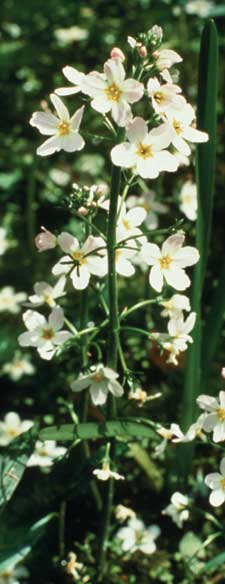 But
interesting changes in behaviour occur as the water level drops, if the
pool dries in July or August. The roots then play a more important part,
anchoring the plan to the mud, keeping it alive by transmitting moisture.
In these conditions, the leafy stems grow rapidly and spread outwards to
prevent any other plant or seedling from obtaining light and space. Water
Violets are capable of asserting themselves and will not tolerate interference
from others. Equally, this is indicative of the growth and gain for Water
Violet people if ever they involve themselves in the physical world. When
the water rises again the rooted plant releases the individual stems and
leaves through a process called 'stolon budding' and they float upward to
cover the available space.
But
interesting changes in behaviour occur as the water level drops, if the
pool dries in July or August. The roots then play a more important part,
anchoring the plan to the mud, keeping it alive by transmitting moisture.
In these conditions, the leafy stems grow rapidly and spread outwards to
prevent any other plant or seedling from obtaining light and space. Water
Violets are capable of asserting themselves and will not tolerate interference
from others. Equally, this is indicative of the growth and gain for Water
Violet people if ever they involve themselves in the physical world. When
the water rises again the rooted plant releases the individual stems and
leaves through a process called 'stolon budding' and they float upward to
cover the available space.
Bach commented directly on this pattern of growth with
unattached roots and freedom to float:
If so, the beautiful Water Violet, which floats so freely
on the surface of our clearest streams, will help you...to stand absolutely
alone in the world, gaining the intense joy of complete freedom.
And later:
They do not often form strong attachments even to those
nearest them.
This may be the clearest indication yet that Bach was looking
at the plants as a literal emblem of the soul condition.
(from Bach Flower Remedies: Form & Function, Chapter
7, pp. 123-125)
Water Violet photos by Julian Barnard, line drawing by Catalina
O'Brien
Bach's Legacy:
A Spiritual Understanding of Nature and the Human Soul
Barnard begins his book speaking of Bach's belief in the "Grand
Design behind the physical world of living beings." He ends it with
Bach's contention that the key for overcoming disease is found within the
transformation of our own lives. In other words, Bach's legacy is a spiritual
understanding of Nature, and a path for the spiritual transformation of
the soul. Yet, can we truly say that these spiritual teachings are what
most people today seek from the Bach flower remedies?
In discussing Bach's philosophical treatise, Heal Thyself,
Barnard comments:
From the perspective of a new century it
begins to be clear that Bach was intent on two separate purposes. One
the one
hand he had discovered a new set of remedies and he wanted people to
use them... On the other, he was the herald for a new world, a voice
crying in the medical wilderness of materialism and ignorance. The second
purpose is easy to forget and hard to accept. The two became separated
at an early stage, maybe well before Bach died. The message from spiritual
reality became subsumed into the opportunity for people to avail themselves
of floral healing.
—Julian Barnard, from Chapter 4, pp 80-81
Form & Function
is a major contribution to re-enlivening the spiritual
legacy of Dr. Bach. It is a call to flower essence therapists and researchers
to continue the unfinished task of learning the healing language of the flowers
and helping troubled humanity find the path to soul awakening. This is a
book that should be read by every serious practitioner of flower essence
therapy.
Read an excerpt from the book on the Impatiens flower essence.
* Matthew Wood and Peter Morrel
have researched possible influences on Dr. Bach's work, relating to the arborivital
remedies of Dr. Robert Cooper and LeHunte Cooper.
References
Barnard,
Julian, Bach Flower Remedies: Form & Function (Great Britain: Flower
Remedy Programme, 2002)
Barnard,
Julian, ed., Collected Writings (London: Ashgrove Publishing, 1999)
Barnard,
Julian, The Healing Herbs of Edward Bach (Bath: Ashgrove Press, 1995)
Barnard,
Julian, Patterns of Life Force, (Hereford: Flower Remedy Program, 1987)
Miller,
Douglas, ed. and trans., Goethe: Scientific Studies - Volume 12 of Goethe,
The Collected Works (Princeton: Princeton University Press, 1995)
Morrel,
Peter, "From Cooper Club To Flower Essences:
A Portrait Of British Homeopathy 1870-1930,"August 1998, Homeopathy Online
#6
Wood,
Matthew, Vitalism: The History of Herbalism, Homeopathy, and Flower Essences
(Berkeley, CA: North Atlantic Books, 2000)
|



![]() and then Add to Home Screen.
and then Add to Home Screen.








 This
statement is apt as a description of the plant, too. For these are flowers
which lead their lives with great precision, clarity and purpose.
This
statement is apt as a description of the plant, too. For these are flowers
which lead their lives with great precision, clarity and purpose.
 But
interesting changes in behaviour occur as the water level drops, if the
pool dries in July or August. The roots then play a more important part,
anchoring the plan to the mud, keeping it alive by transmitting moisture.
In these conditions, the leafy stems grow rapidly and spread outwards to
prevent any other plant or seedling from obtaining light and space. Water
Violets are capable of asserting themselves and will not tolerate interference
from others. Equally, this is indicative of the growth and gain for Water
Violet people if ever they involve themselves in the physical world. When
the water rises again the rooted plant releases the individual stems and
leaves through a process called 'stolon budding' and they float upward to
cover the available space.
But
interesting changes in behaviour occur as the water level drops, if the
pool dries in July or August. The roots then play a more important part,
anchoring the plan to the mud, keeping it alive by transmitting moisture.
In these conditions, the leafy stems grow rapidly and spread outwards to
prevent any other plant or seedling from obtaining light and space. Water
Violets are capable of asserting themselves and will not tolerate interference
from others. Equally, this is indicative of the growth and gain for Water
Violet people if ever they involve themselves in the physical world. When
the water rises again the rooted plant releases the individual stems and
leaves through a process called 'stolon budding' and they float upward to
cover the available space.
